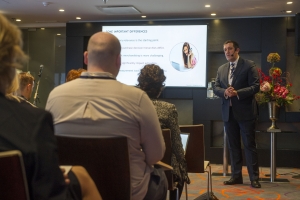Delegates to a meat industry conference in Estonia, a market where online grocery is very much in its infancy and accounts for just 1% of sales, heard in detail about the halo effect of eCommerce where shoppers research online but purchase offline.
Speaking at the event in Tallinn, which was hosted by a leading Nordic food company, Nick Kirby, Shopper, eCommerce & Analytics Director at category management and shopper management specialist Bridgethorne, explained how shoppers increasingly rely on eCommerce, regardless of how they make the actual purchase to find product information, price, reviews. Depending upon the category, the halo effect of eCommerce can be as much as ten times the number of direct sales, Kirby explained, and is a key part of shopper and consumer decision making.
“The aim of the presentation was to share some practical tips with Estonian retailers attending the event,” explains Kirby. “The focus was on providing some simple, practical tips to help the audience get the basics right, particularly when it comes to imagery, product names and taxonomy. I also wanted to take the opportunity to provide some broader context as to where online sits within the shopper journey and also some key evolving trends. For example, globally, 4.4% of all FMCG sales are online and growing fast in a consumer goods market that is experiencing limited growth.”
Kirby explained to delegates that, in a world in which shoppers are subject to greater influences and have more choices than ever, embracing eCommerce requires a move from an old model of simply increasing distribution points for the same product with the same communication message in more than one channel.
“It now requires the delivery of a seamless brand experience,” he told delegates, “whilst tailoring ranges, products, communication and activation to suit the differing behaviour each shopper demonstrates each time they shop, each place they shop at a specific time.”
During his presentation, Kirby also outlined the importance of retailers’ optimising their digital shelves. This included key tips for product images, product names which are generally seen as one of the most important elements in onsite search, and how good taxonomies are informed by shopper behaviour and encompass all available products in a way that a customer can browse to their desired product in as few clicks as possible.
The presentation concluded with a look at some evolving trends, including personalised online experiences; optimisation by device; the growing use of room-based screenless devices and the prevalence of new eCommerce delivery options.
Bridgethorne has added a series of eCommerce services to its portfolio. These services range from eCommerce capability assessments, digital shelf audits & planning and eCommerce team training to understanding the management of multi-channel and pureplay retailers, the eCommerce shopper journey and building winning eCommerce strategies and commercial plans.
These form part of Bridgethorne’s comprehensive series of approaches that help supplier organisations address key aspects of Integrated Shopper Management as it pertains to their particular circumstances. Areas that can be addressed range from shopper understanding, through strategy and planning right up to activation and evaluation.
Ends.

